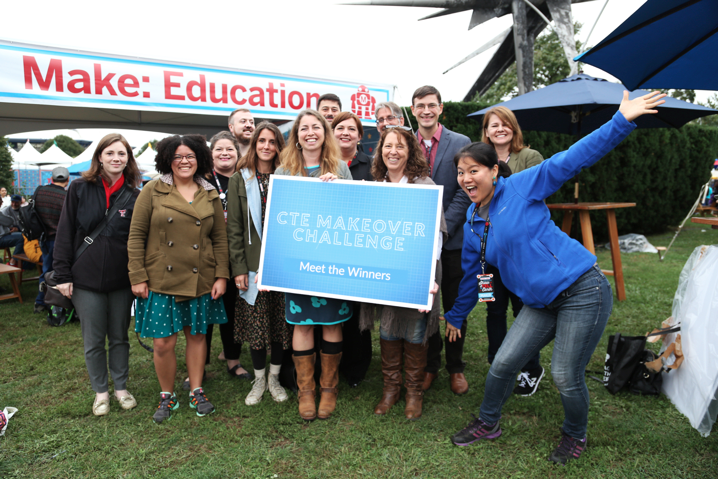
By Steve Davee
Maker Ed is honored to have been a part of the recent CTE Makeover Challenge provided by the US Department of Education and administered by Luminary Labs. The Challenge’s stated purpose was to call “on high schools to design makerspaces that strengthen next-generation career and technical skills.”
By the numbers:
- 640+ Challenge entrants
- Nearly 300 Second Round “Blueprint” Submissions received
- The U.S. Department of Education provided a $200,000 cash prize purse that was split among the 10 winners
- 21 sponsors gave in-kind donations worth $375,000+; in-kind donations included Bootcamp training for all Challenge entrants and tools, equipment, and individualized consulting for the 10 winners
The winning programs represent a great diversity of spaces, including school libraries, the use of mobile carts, adapting classrooms and existing shop spaces, and developing dedicated makerspaces. Each program has a unique focus and approach that continues the maker education tradition of honoring the innate diversity making and maker education more student driven and inquiry, problem, and project-based. Highlighted below is an excerpt of some of the wonderful advice from many of the winners on what schools should consider when developing making programs:
“Never be afraid to start small! Putting a simple call out to your school community for old legos, crafting supplies and more can yield a great response to start a collection of crafting materials…Visiting other makerspaces and learning from some of the amazing maker educators who have been doing this work for years is incredibly inspiring. These visits will spark ideas for your own projects and build-outs.”
CAPITAL CITY PUBLIC CHARTER SCHOOL, Washington, D.C.
“Don’t let lack of funding postpone the development of your makerspace. Start small. A deconstruction zone to take apart appliances and electronics costs nothing. (Safety tip: Cut the electrical cord on equipment before disassembling it, so that it can’t be accidentally plugged into a power source). Let students experiment. Allow them to be a driving force in growth of your makerspace.”
CLEARWATER HIGH SCHOOL, Piedmont, MO
“A school makerspace is the idea that students can and should learn by making. That idea can start life in a small bin or box of crafting supplies and grow into a complete makerspace full of digital fabrication tools, electronics and more. The Makerspace Starter Kit is a great tool to help educators get started building a classroom makerspace.”
DOMINION HIGH SCHOOL, Sterling, VA
“Student and teacher interest will guide the evolution of the space more than the tools. During the development, consider a variety of instructional techniques and the presentation of the tools. How can the new tools and their affordances be made most salient to students, teachers, and the community? Tools such as vinyl printers, sewing machines, and CNCs (after demonstration) make great gateway tools because they are easy for novices to see the possibilities available in a makerspace. More sophisticated and unfamiliar tools, such as Laser cutters, provide great demos for exciting imaginations.”
THEODORE ROOSEVELT HIGH SCHOOL, San Antonio, TX
“Plan ahead and understand that the process will take time to complete. Tools, machines, furniture, and equipment can all come from different companies and vendors, so it is important to allow plenty of time for purchasing, delivery, installation, and training on the equipment. Also, find a local business or industry to help support your plan. Business and Industry can provide valuable support and advice along the way.”
THINC COLLEGE & CAREER ACADEMY, Lagrange, GA
Explore More:
- CTE Bootcamp: Lessons
- CTE Bootcamp Webinars: CTE YouTube Playlist
- Maker Ed’s Possibility boxes
- Maker Ed’s Webinar Videos: Introduction to the Maker Movement and Designing Your Makerspace
- CTE Bootcamp: Resources
- 2-min Winner makerspace tours video here

Leave a Reply